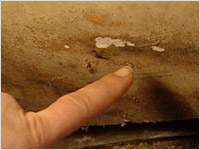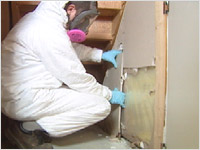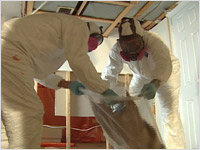| | | | |
| |


|
|
When Brigitte developed an itchy throat and a cough every time she went to her basement to do laundry, she began to suspect (hope?) that she was allergic to laundry. Not so. She had toxic mould in her 100-year-old house and for that, she called in the big guns – mould removal experts.
 |
 |
 |
 |
 |
 |
|
 |
DO call in air quality control experts to test your house if you suspect a problem.
|
 |
DON’T tackle the job yourself if you find mould. Protect your health and have the experts do it.
|
|
 |
 |
 |
 |
Brigitte Gall – Bounty Queen Alien Mould Hunter
- When Brigitte’s doctor suspected that Brigitte might have a sensitivity to mould, she went looking to see what she could find. Sure enough, she found visible mould present in her basement. Here’s what to look for if you think there’s a problem: (see figs. A & B)
- A musty odour.
- Discolouration of walls or floors. If you’d had a leak in a ceiling or a basement, mould is likely present.
- Black growth around bathroom tiles. This likely masks a much larger problem.
- Foggy windows. This indicates an improper seal.
- Cracked or peeling paint. This means there’s moisture there and where there’s trapped moisture, there’s likely mould.
- Increased allergy symptoms. Some moulds are invisible but they can affect those living in the house.
 |
|
 |
| Fig. A |
|
Fig. B |
- Some moulds cause irritation only to those of us who suffer from allergies to airborne substances. But toxic mold causes problems for anyone who comes in contact with it. Some toxic molds are carcinogenic.
- If you find or suspect mould, the first step is to collect an air sample. Mould removal experts do microscopic analyses to determine what types of mould are present in your home. If you find or suspect mould, the first step is to collect an air sample. Mould removal experts, like Greenough Environmental, do microscopic analyses to determine what types of mould are present in your home. (see fig. C)
- If toxic mould is present, you need to have it removed, but under controlled circumstances by qualified mould removal experts. They isolate the affected area and establish negative pressure so that there is no transfer of mould spores to other parts of the house. And they wear really cool decontamination suits. (see fig. D)
 |
|
 |
| Fig. C |
|
Fig. D |
- Once the mould was removed from Brigitte’s basement, she decided that it was the perfect opportunity to spray polyurethane insulation. It’s an excellent insulator for basements because it has a high R value and adheres directly to surfaces. Moisture can’t build up between it and the walls like it can with batting insulation. Once it’s in place, simply drywall over it and you have a warm, dry basement.
|
|